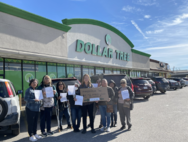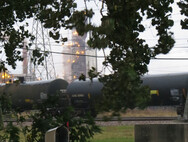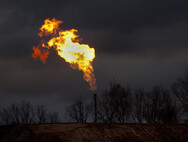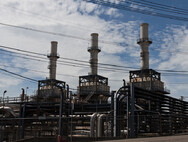Content Archive
Year
June 16, 2025
Trump quietly shutters the only federal agency that investigates industrial chemical explosions
Eliminating the CSB will come at a cost to the safety of plant workers and neighboring communities, especially along the Gulf Coast, where the bulk of the U.S. petrochemical industry is concentrated, said former CSB officials and environmental groups. “Closing the CSB will mean more accidents at chemical plants, more explosions and more deaths,” said Beth Rosenberg, a public health expert who served on the CSB board from 2013 to 2014. On average, hazardous chemical accidents happen once every other day in the U.S., according to Coming Clean, an environmental health nonprofit. Coming Clean documented 825 fires, leaks and other chemical-related incidents between January 2021 and October 2023. The incidents killed at least 43 people and triggered evacuation orders and advisories in nearly 200 communities.
Read MoreMay 8, 2025
Year-long study reveals toxic chemicals in popular dollar store products
A new year-long study from the Campaign for Healthier Solutions (CHS) claims that many popular products found at the biggest dollar store chains across the country contain toxic chemicals. The report showed that nearly 50 personal care, baby, beauty, and cleaning products were found to have toxic chemicals. Many of these products were kids’ toys or baby products, which raises concerns for parents – especially parents of young kids, who often put things in their mouths."Busy parents shouldn't have to scan the ingredients list of every product they buy to make sure it's safe for our families,” Yolanda Brown Alston, director of workforce programs at Harambee House, said in a news release. “Dollar stores need to step up on chemical safety and provide quality products that add value to our communities.”
Read MoreMay 7, 2025
Las pruebas impulsadas por la comunidad nuevamente revelan sustancias químicas preocupantes en los productos de las tiendas del dólar
La Campaña para Soluciones más Saludables / Campaign for Healthier Solutions (CHS, por sus siglas en inglés) publicó hoy los resultados del esfuerzo de todo un año para recopilar, analizar y examinar los productos de las tiendas del dólar en busca de sustancias químicas preocupantes. Los productos preocupantes resaltados que se compraron en Dollar Tree/Family Dollar y/o Dollar General incluyen: Loción para bebé “Baby Shark” que contiene un químico liberador de formaldehído; crema hidratante diaria que contiene un producto químico prohibido en los cosméticos europeos; pulseras con iluminación, rosas de plástico y mini cubetas de dulces contenían plomo; los productos infantiles hechos de cloruro de polivinilo o PVC y los recibos de compra de ambas tiendas del dólar contenían bisfenol-S.
Read MoreMay 7, 2025
Community-driven testing again reveals chemicals of concern in dollar store products
The Campaign for Healthier Solutions (CHS) today published the results of a year-long effort to collect, test, and screen dollar store products for chemicals of concern. Highlighted products of concern purchased at Dollar Tree/Family Dollar and/or Dollar General include: “Baby Shark” baby lotion containing a formaldehyde-releasing chemical; daily moisturizer containing a chemical banned in European cosmetics; light-up children’s bracelets, plastic roses and mini candy pails containing lead; children’s products made with polyvinyl chloride or PVC, and receipts containing bisphenol-S. Published the week of Mother’s Day, “Product Testing for the People: Pitfalls, Persistence, and Progress in Transforming Dollar Stores” provides safe shopping tips for families and actionable recommendations for Dollar Tree and Dollar General to expand, improve, and enforce their chemical policies. The report also highlights loopholes in federal law that allow companies to sell products containing chemicals of concern, showing the importance of corporate action. Take action!
Read MoreMay 5, 2025
Sweeping exemption requests from polluters are an affront to fenceline communities
Today 34 individuals and organizations sent a letter to the U.S. Environmental Protection Agency (EPA) Administrator Lee Zeldin, opposing an unprecedented Presidential exemption that would allow hundreds of chemical plants to simply ignore stricter emissions standards that were finalized last year. Among these was the “HON rule”, which requires over 200 chemical plants - shown to contribute to high cancer risk in fenceline communities - to conduct fenceline monitoring for six cancer-causing air pollutants and take action to prevent leaks if emissions exceed certain thresholds. A recent request from chemical industry lobbyists seeks to exempt all HON facilities from complying with the new standards.
Read MoreApril 21, 2025
The Government’s Chemical Disaster Tracking Tool Just Went Dark
The Environmental Protection Agency just hid data that mapped out the locations of thousands of dangerous chemical facilities, after chemical industry lobbyists demanded that the Trump administration take down the public records. The webpage was quietly shut down late Friday, according to records viewed by The Lever — stripping away what advocates say was critical information on the secretive chemical plants at highest risk of disaster across the United States. The data was made public last year through the Environmental Protection Agency (EPA)’s Risk Management Program, which oversees the country’s highest-risk chemical facilities. These chemical plants deal with dangerous, volatile chemicals — like those used to make pesticides, fertilizers, and plastics — and are responsible for dozens of chemical disasters every year. A spokesperson for Coming Clean, an environmental health group focusing on the chemical industry, told The Lever that the organization was “surprised” to see the webpage taken down and that its staff had accessed the data as recently as Friday morning.“We know that industry had suggested it, so it seems like [regulators] are following industry’s lead,” the spokesperson added.
Read MoreMarch 11, 2025
Trump Administration’s Decision to Rehash Chemical Disaster Prevention Rules Will Endanger Millions of Workers and Fenceline Community Residents
The U.S. Environmental Protection Agency (EPA) announced Thursday that it plans to rehash regulations under the Risk Management Program (RMP). The decision comes after lobbyists for the chemical industry sent a letter requesting the agency weaken the rule requiring nearly 12,000 highly hazardous industrial facilities to prevent and plan for chemical disasters.
The EPA is bending to the will of corporate lobbyists who are seeking to eliminate stronger rules finalized in 2024. These more protective rules were the result of years of public debate and incorporated input from industry and the public alike, including advocacy by environmental justice, labor, occupational and public health, and environmental organizations.
Read MoreMarch 7, 2025
Trump administration considers rolling back chemical plant safeguards
“It would mean a real disservice to communities, first responders and workers,” said Adam Kron, an attorney with Earthjustice. “It would put them in greater harm’s way from these chemical disasters.” Earthjustice is part of a coalition of environmental groups that tracks chemical disasters. This coalition has found that since January 2021, there have been more than 1,100 chemical incidents. The news of a potential rewrite comes days after Trump’s address to a joint session of Congress, in which he vowed to take on toxic chemicals, saying, “our goal is to get toxins out of our environment, poisons out of our food supply and keep our children healthy and strong.” Yet that rhetoric also comes as Trump has pledged broad deregulatory action, which could clash with upholding chemical safeguards.
Read MoreMarch 5, 2025
Sustainable Chemistry Cannot Deliver Environmental Justice Unless Fenceline Communities are Protected
So-called sustainable and/or green chemistry is being promoted in many circles as a means to both harness chemistry innovation to support more sustainable economies and reduce the environmental and public health impacts of chemical manufacturing. As we work to build research and policy which deliver health protections and justice to communities most impacted by the toxic harm of the chemical industry, we must critically examine sustainable chemistry initiatives and ask who will benefit from the technologies and practices. When something is promoted as “sustainable chemistry,” who is it sustainable for? Read more of this joint blog from Coming Clean and EJHA.
Read MoreFebruary 7, 2025
Chemical Companies Pushing to Hide Information on Potential Disasters
"The chemical industry is asking the Environmental Protection Agency ... to hide chemical facilities at the highest risk of disaster and their safety records from public view." This story in The Lever highlights Coming Clean's and EJHA's report on "Chemical Incident Tracking 2021-2023," part of our decade-long collaboration to prevent chemical disasters.
Read MoreLatest News Share this page: |
The Campaign for Healthier Solutions Farmworker Health and Justice Team Chemical Disaster Prevention Program |
Subscribe to our |
© 2025 Coming Clean Inc. | Coming Clean, Inc., 28 Vernon Street, Suite 434, Brattleboro, VT 05301 • (802) 251-0203










